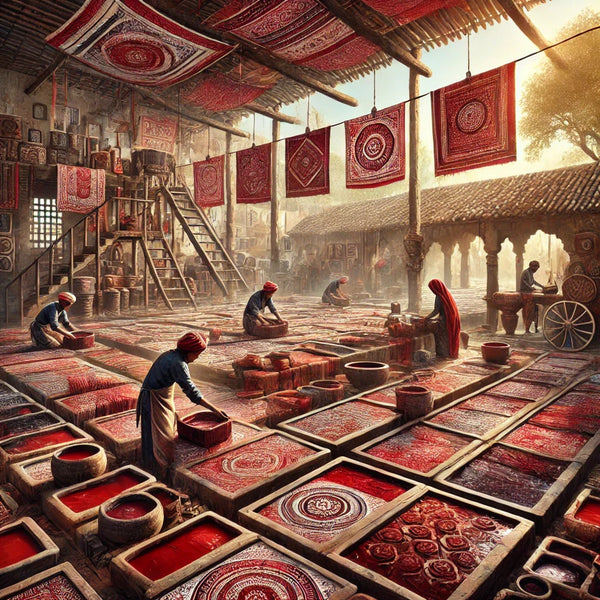Ajrakh printing is one of Gujarat’s most cherished textile crafts, known for its intricate geometric patterns and the use of natural dyes. Among these dyes, alizarin, a red dye extracted from the madder plant (Rubia tinctorum), plays a crucial role in bringing out the deep red hues that contrast beautifully with indigo blues. This centuries-old practice continues to be an essential part of sustainable fashion, and at Vasudhaa Vastrram, we take pride in preserving and promoting such traditional techniques through our organic collections.
The Role of Alizarin in Ajrakh Printing
Ajrakh printing is a labor-intensive process that involves multiple stages of resist printing and dyeing. The use of alizarin is a key step in achieving vibrant and long-lasting red shades. Here’s how it contributes:
- Natural Mordant Dyeing: Alizarin is not a direct dye but a mordant dye, which means it needs a mordant like alum or iron to fix it onto fabric. This process enhances color depth and ensures longevity.
- Enhancing Color Contrast: Ajrakh textiles are known for their striking contrasts of deep indigo, black, and red. Alizarin is applied after the fabric has undergone multiple layers of resist printing, helping to develop a rich, earthy red tone.
- Sustainability and Eco-friendliness: Unlike synthetic dyes, alizarin obtained from natural sources is biodegradable and non-toxic, making it an ideal choice for sustainable fashion.
- Traditional Application: Artisans use wooden blocks to stamp intricate designs onto the fabric using a resist paste. Once the resist is removed, alizarin is applied to specific areas, revealing the brilliant red color after processing.
The Process of Alizarin Dyeing in Ajrakh
- Block Printing with Mordants: The fabric is first printed with a mordant paste (usually iron or alum) to define areas where the red color will develop.
- Dyeing with Alizarin: The fabric is immersed in an alizarin bath, which reacts with the mordanted areas, creating a deep red hue.
- Sun Exposure: After dyeing, the fabric is dried in the sun, a crucial step that enhances color vibrancy through oxidation.
- Final Washing: The fabric is washed multiple times to remove excess dye, leaving behind crisp, well-defined motifs.
Alizarin and Sustainable Fashion
The use of alizarin in Ajrakh printing aligns perfectly with the principles of slow fashion and sustainability. Since it is derived from plants, it supports eco-conscious textile production and helps in reducing the environmental impact of synthetic dyes. At Vasudhaa Vastrram, we incorporate this traditional technique into our collections, ensuring that every piece not only tells a story of heritage but also promotes responsible fashion.
Conclusion
The integration of alizarin in Ajrakh printing is a testament to the rich heritage of Gujarat’s textile industry. This natural dye, with its deep-rooted history, continues to be an essential element in crafting exquisite, sustainable textiles. By supporting such artisanal techniques, we contribute to the preservation of a timeless craft while embracing the beauty of naturally dyed fabrics.
Discover our Ajrakh-printed collection at Vasudhaa Vastrram, where tradition meets sustainability. Each piece is a work of art, dyed with nature’s finest colors and crafted for a conscious future.






